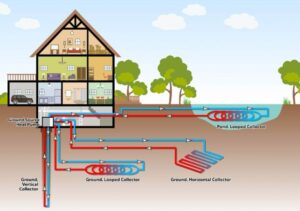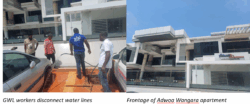It’s another Thursday and it always feels great to connect with good people like you out there, I do believe you are keeping well. Speaking of feeling great and keeping well, have you noticed it’s getting hotter and hotter by the day? The easy resort has always been to Air Conditioners (ACs) for some comfort, today, we will provide other AC cooling technologies that we can all consider. By special courtesy of IFC EDGE’s User Guide, do find below potential technologies or strategies for consideration.
Simple air-conditioners fitted in windows and through-the wall unitary air-conditioners are the most common type of air-conditioners used in individual residential units. Apartment buildings may use packaged air conditioners located on roof tops with ducted air flow. However, these are the least efficient types of systems. Various air-conditioning systems are available that achieve higher cooling efficiency, including split air conditioners, multi-split air conditioners, VRF systems and chillers.
Split air-conditioners are direct expansion (DX) mechanical refrigeration systems with a single condenser unit outside serving a single fan coil unit (evaporator) inside the building, with refrigerant carried between the two in narrow tubes through the wall. These do not require ducts, and are more efficient than ducted systems. But they can only serve fan coil units located at a limited distance from the external condenser unit.

Multi-split air conditioners are like split systems, except that a single large condenser unit is connected to several fan coil units with individual tubes. The added advantage is the fewer number of outside units. But these systems can only serve spaces that are at similar temperature conditions.
Variable Refrigerant Flow (VRF) systems have one condensing unit with multiple indoor units, each of which can be individually controlled. These systems use refrigerant as the medium for heat transfer. The system runs by modulating the amount of refrigerant that is sent to each evaporator, running only at the rate needed to deliver the cooling required by each internal unit. They systems are a step up from multi-split systems because they can serve zones with different thermal needs, including zones that may be in heating mode while other zones are in cooling mode.
VRF systems accomplish this through compressors that can modulate their speed and the refrigerant flow. The refrigerant is distributed through a piping network to multiple indoor fan-coil units, each capable of individual zone temperature control through a common communications network. The system runs only at the rate needed to deliver the temperature change required by each internal unit. To realize savings from a VRF system, the spaces must be zoned separately with their own individual thermostats. The three basic types of VRF systems include: cooling only, VRF heat pump that provides both heating and cooling but not simultaneously, and VRF with heat recovery that provides heating and cooling simultaneously.
VRF systems may be a particularly good option for buildings with multiple zones or wide variance in heating/cooling loads across many different internal zones. As these systems provide individual control and are the most versatile of the multi-split systems, VRF systems may be the best for buildings such as homes, offices, retail buildings, education, healthcare buildings, or hotels and resorts. The outdoor units can be fitted to as many as 48 internal units.
Due to the way the internal units are connected to the external unit, a breakdown of one internal unit will not compromise the rest of the system. The speed of the outdoor compressors can change to operate in a range of 6% to 100% capacity. Capacities have typically ranged from 5.3 to 223 kW for outdoor units and from 1.5 to 35 kW for indoor units, but new products are continually being introduced. Multiple outdoor units can be used if an even greater range of capacity is required. Note that the same measure applies to a Variable Refrigerant Volume (VRV) cooling system, which is a patented name for a type of VRF system.
Chillers. Chillers deliver cooling through chilled water which has much higher heat capacity than air, allowing heat to be transferred more efficiently. Chilled water is circulated to provide comfort cooling throughout a building. The system has four components: i) Compressor, ii) Condenser, iii) Thermal expansion valve, and iv) Evaporator. The compressor compresses the refrigerant and pumps it through the air conditioning system at a designed flow rate and pressure. The compressor technology is a way to distinguish the type of air-cooledchillers: Reciprocating chillers, rotary screw chillers, or scroll chillers. Selection must be made based on many factors including the size of the system; for example, reciprocating compressors are typically 3–510 refrigeration tons.
The cycle begins in the evaporator where a liquid refrigerant flows over the evaporator tube bundle and evaporates, absorbing heat from the water circulating through the bundle. The refrigerant vapor is drawn out of the evaporator by the compressor. The compressor compresses the refrigerant raising its pressure and temperature, and pumps the refrigerant vapor to the condenser.
The refrigerant condenses in the condenser tubes, giving up its heat to the air or water that is cooling the condenser. The high-pressure, liquid refrigerant from the condenser then passes through the expansion device that reduces the refrigerant pressure and temperature as it enters the evaporator. The cold refrigerant again flows over the water coils absorbing more heat and completing the cycle.
Air-cooled chillers use air to cool the condenser and are suitable for climates where water supply is scarce or high humidity reduces the efficiency of the cooling towers. Water-cooled chillers are like air cooled chillers except that water is used to provide the condenser cooling. Air-cooled chillers cost significantly less per ton than water-cooled systems primarily because they require fewer components to build and operate and require less support equipment and plumbing. Installation of an air-cooled chiller is faster and easier than that of a watercooled chiller.
However, the efficiency of water-cooled chillers is typically higher because of the higher heat capacity of water compared to air. A water-cooled system is the best option when reducing operating costs is of paramount concern and the project can invest in a system with a longer payback period.
Water cooling does involve a higher initial investment since both a chiller and a circulating tower system are required, which in turn require additional pumps, piping and tanks. Also, water cooling systems consume considerable amounts of water due to evaporation, purging and bleeding.
Absorption Chiller. An absorption chiller is a type of air-cooling device that absorbs waste heat instead of electrical energy to provide cooling. An absorption chiller has a low COP. However, it can reduce operating costs because it is powered by waste heat. An absorption chiller is a much more cost-effective alternative to a traditional cooling system due to the use of waste heat as fuel and lower maintenance. Waste heat is the result (byproduct) of building processes or industrial processes that is not being put to practical use.
This waste heat is captured to generate cooling as an emission-free substitute for costly purchased fuels or electricity. It is thus a no-cost fuel source which can improve the overall energy efficiency in a facility. Absorption chillers are more cost-effective in large-sized buildings which are owned and operated by the same manager. This measure can be claimed if a power generator fueled by Diesel or Natural Gas provides power to the building, and a recovery technology is installed to capture the waste heat from the generator for the cooling cycle.
Additionally, the absorption chiller system must achieve a Coefficient of Performance (COP) greater than 0.7 under ARI conditions. By providing a mechanical refrigeration system that uses the waste heat generated in other processes such as electricity generation or industrial processes to run an absorption chiller, the energy needed to deliver the required cooling and/or heating can be reduced significantly.
To claim this measure, the design team must demonstrate that the absorption chiller(s) achieve an efficiency greater than 70% (COP >0.7). Although the equipment efficiency is not high, it uses waste heat to power the chiller, thus achieving a higher whole-system efficiency. If this measure is selected, the assumptions in the Design tab must be verified. The user must select the appropriate fuel under ‘Generator’, and input the appropriate value for ‘% of Electricity Generation Using [Fuel].’
Ground source heat pumps (GSHPs), sometimes referred to as geothermal heat pumps (GHPs), are used to heat and cool buildings by absorbing naturally existing heat from the earth. A GSHP/GHP takes advantage of the more constant below-ground temperature within the earth (soil or water) compared to the more variable outside air temperature. Below-ground temperature is warmer than the air during the winter and cooler than the air in the summer. A GHP takes advantage of this by exchanging heat with the earth through a ground heat exchanger. A GHP can reach a high COP of 3 to 5.2 on the coldest winter nights, compared to air-source heat pumps that only reach up to a 1.5 to 2.5 COP on cool days.
Ground source heat pumps are a clean alternative utilizing renewable and reliable sources of energy37 . The base case includes an air conditioning system based on ASHRAE 90.1-2016, which is typically a Packaged Terminal Air Conditioner (PTAC) (a ground source heat pump is not a default base case system).
When a ground source heat pump is selected as an energy efficiency measure, the heating and/or cooling energy is reduced depending on the load on the building systems. The energy use by pumps is slightly increased due to the operation of the system.
Four major types of ground source heat pump systems (GHPs) are available. Of these four types, three systems – the horizontal, vertical, and pond systems – are closed loop systems. The fourth major type of GHP is the open loop system. A closed loop system recirculates antifreeze or water through a loop of piping that is either buried in the ground or submerged under water.
A heat exchanger transfers heat between the refrigerant in the heat pump and the antifreeze/water solution. An open loop GHP system pumps water from a ground or water source, circulates the water and then discharges it once the heat has been transferred into or out of the water. It draws fresh water instead of recirculating the same water again.
There you have it folks, your alternate cooling systems, if you already using or experienced any do share, your feedback is always valued. For more info, do visit edgebuildings.com.
The writer is the Executive director of Yecham Property Consult
& Founder of Ghana Green Building Summit.
Email: [email protected]
LinkedIn: Cyril Nii Ayitey Tetteh










